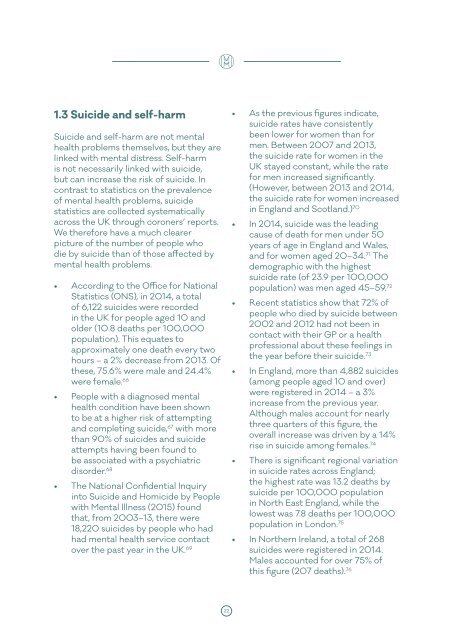FUNDAMENTAL FACTS ABOUT MENTAL HEALTH 2016
fundamental-facts-about-mental-health-2016
fundamental-facts-about-mental-health-2016
You also want an ePaper? Increase the reach of your titles
YUMPU automatically turns print PDFs into web optimized ePapers that Google loves.
1.3 Suicide and self-harm<br />
Suicide and self-harm are not mental<br />
health problems themselves, but they are<br />
linked with mental distress. Self-harm<br />
is not necessarily linked with suicide,<br />
but can increase the risk of suicide. In<br />
contrast to statistics on the prevalence<br />
of mental health problems, suicide<br />
statistics are collected systematically<br />
across the UK through coroners’ reports.<br />
We therefore have a much clearer<br />
picture of the number of people who<br />
die by suicide than of those affected by<br />
mental health problems.<br />
• According to the Office for National<br />
Statistics (ONS), in 2014, a total<br />
of 6,122 suicides were recorded<br />
in the UK for people aged 10 and<br />
older (10.8 deaths per 100,000<br />
population). This equates to<br />
approximately one death every two<br />
hours – a 2% decrease from 2013. Of<br />
these, 75.6% were male and 24.4%<br />
were female. 66<br />
• People with a diagnosed mental<br />
health condition have been shown<br />
to be at a higher risk of attempting<br />
and completing suicide, 67 with more<br />
than 90% of suicides and suicide<br />
attempts having been found to<br />
be associated with a psychiatric<br />
disorder. 68<br />
• The National Confidential Inquiry<br />
into Suicide and Homicide by People<br />
with Mental Illness (2015) found<br />
that, from 2003–13, there were<br />
18,220 suicides by people who had<br />
had mental health service contact<br />
over the past year in the UK. 69 •<br />
•<br />
•<br />
•<br />
•<br />
•<br />
As the previous figures indicate,<br />
suicide rates have consistently<br />
been lower for women than for<br />
men. Between 2007 and 2013,<br />
the suicide rate for women in the<br />
UK stayed constant, while the rate<br />
for men increased significantly.<br />
(However, between 2013 and 2014,<br />
the suicide rate for women increased<br />
in England and Scotland.) 70<br />
In 2014, suicide was the leading<br />
cause of death for men under 50<br />
years of age in England and Wales,<br />
and for women aged 20–34. 71 The<br />
demographic with the highest<br />
suicide rate (of 23.9 per 100,000<br />
population) was men aged 45–59. 72<br />
Recent statistics show that 72% of<br />
people who died by suicide between<br />
2002 and 2012 had not been in<br />
contact with their GP or a health<br />
professional about these feelings in<br />
the year before their suicide. 73<br />
In England, more than 4,882 suicides<br />
(among people aged 10 and over)<br />
were registered in 2014 – a 3%<br />
increase from the previous year.<br />
Although males account for nearly<br />
three quarters of this figure, the<br />
overall increase was driven by a 14%<br />
rise in suicide among females. 74<br />
There is significant regional variation<br />
in suicide rates across England;<br />
the highest rate was 13.2 deaths by<br />
suicide per 100,000 population<br />
in North East England, while the<br />
lowest was 7.8 deaths per 100,000<br />
population in London. 75<br />
In Northern Ireland, a total of 268<br />
suicides were registered in 2014.<br />
Males accounted for over 75% of<br />
this figure (207 deaths). 76<br />
22


